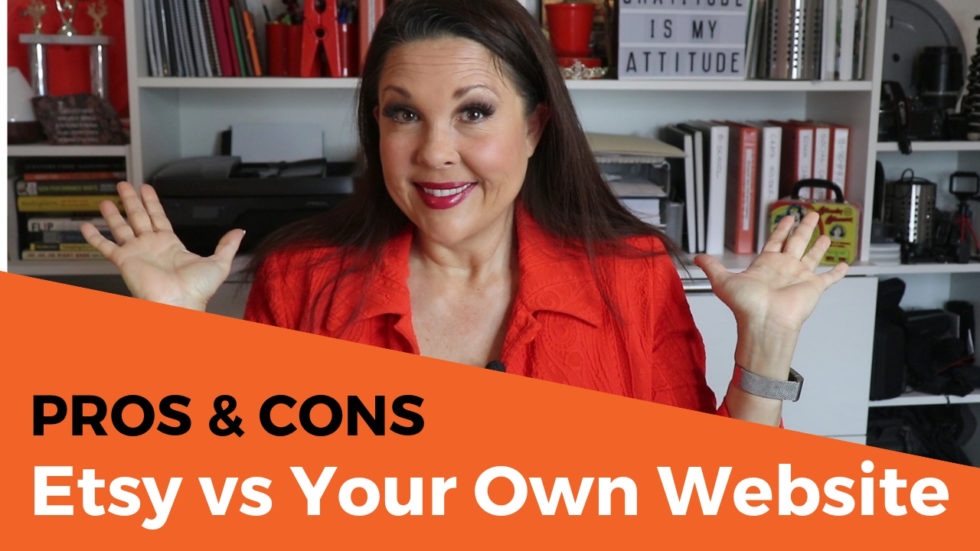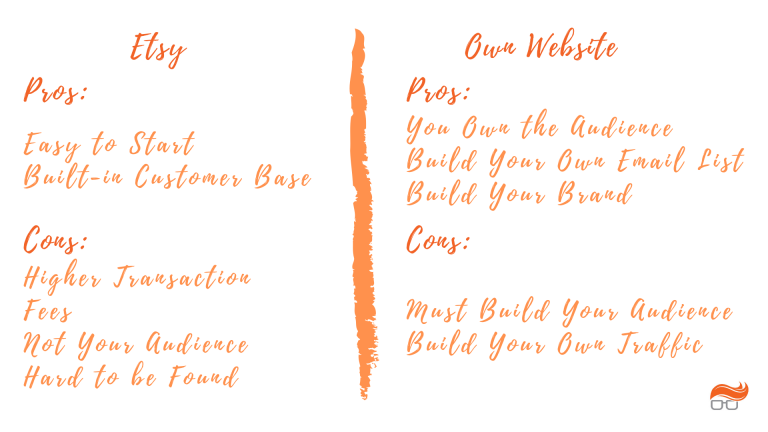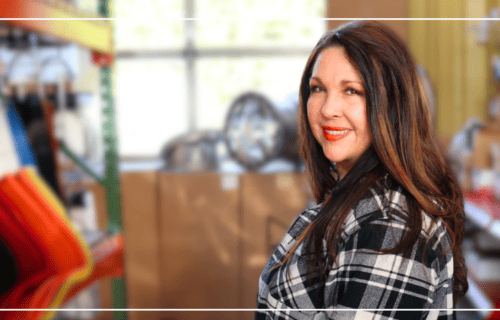
Pros and Cons of Etsy vs Your Own Website
This is a question I hear often – should I have an Etsy shop or should I have my own website? In this video, I go over some of the specifics of each choice so that you can better decide for yourself.
Transcript:
Hey everybody, today I want to answer a question that I see quite often, and that question is, “Should I sell my products on Etsy or should I have my own website?” Well, I’m going to dig into a little bit of the pros and the cons of each of those choices, and I want to kick it off by talking about the fact that I know in business, that the biggest mistakes I’ve made in my own business have always happened when I didn’t even know the right questions to ask.
I think this really goes into that category, because first of all, I want to separate what is the difference between having your own website and having an Etsy site? They’re really not the same thing. We’re comparing apples and oranges. To really lay that out a little bit more easily, and make it make sense, is a question would be, if you could have your products in somebody else’s boutique, like downtown Main Street, and you could just have a little section in that store, that’s option one, and that would be like Etsy. Or, number two, do you want to set up your own boutique in downtown? That’s really the question is are you really just dabbling? Are you just getting started?
Etsy vs. Own Website
In talking about the pros and the cons, let’s go to Etsy for a moment. It’s going to be a really low barrier to entry to get started. If we look at the Etsy website, we’ll just go ahead and scroll on over here, and you can see to start your own store, that you can have a 20 cent listing fee is all it costs you to list a product.
Pricing
Now, your other fees on top of that, you’re going to have a 5% transaction fee, and then that’s going to Etsy, plus you’ll have 3%, plus 25 cents a transaction for your credit card processing. I’ll talk a little bit more about that in just a moment, but to get started, all you really need to have is a credit card on file with them, so they can charge you 20 cents for your listing fee, per product. Then, that keeps it active up to four months. Now, conversely, if we’re looking at just basic pricing, let’s go on over to BigCommerce. This is the solution that I use for my eCommerce store, and I’ll just go ahead and say it. I may be a little bit tainted, because I’ve made my living by having an online store, my own website, that type of thing. But I think it’ll make more sense in a moment.
For BigCommerce, you’re going to kick it off with a 29.95 a month charge. Now, you’re not going to have any of those transaction fees, but you will have any of your credit card processing fees, say through PayPal or Stripe. Square has raised their prices recently, but with Stripe and PayPal, those are 2.9%, so we’re just talking about a tenth of a percentage point, so I’m not going to dig into that granular of detail here. But to go back, that’s just some of the pricing off of the top, just so that is really clear.
Brand Recognition
But then let’s go ahead and go into a little bit more about the audience and who owns it. Because if you’re on Etsy, let’s say somebody buys something, if you buy something on Etsy, now when somebody asks you, “Hey, where did you get that item?” Do you say that, “I got it from the coolest store” or whatever the name of the store is? Or, do you just say, “I got it on Etsy?” Number one, you’re not going to have your own brand recognition, whereas if they buy it on your website, then they’re more likely to say, “Hey, I bought it at TheCoolestStore.com.” You’ll be able to give that away. I know that I’ve worked with an Etsy seller before, I knew her exact store name and I couldn’t find it on Etsy without actually having a link. So, now maybe some things have changed, maybe Etsy’s improved that, but I was really dismayed that I couldn’t find it in search, even though I know the exact name of her store.
Something else that happens, if you have Etsy versus a regular website, or your own website, is that say someone is browsing and they do find your store. Then, it may have the related products, could take people to somebody else’s store. Whatever your item is, and then the related products are down below, so you really don’t get that same brand recognition.
Testing the Market
Let’s talk about too, what is the tipping point? I did a little bit of math, ’cause I really do love doing math, so one of the things is, if you’re just starting out, you want to find out, test your market, find out if this is a good fit. Find out if this is something that you actually want to do. The Etsy route is a great route, just to put your toes in the water, just to find out if this is what you want to do.
But that tipping point for when you will start losing money versus making money is right around $600 a month. If I do the math, at $600 you would have that 5% transaction fee and there’s your $30. If you’re making over $600 a month, maybe at that point is a time where you want to bring on an online store. And here’s the thing, you don’t have to do one or the other. You can do both. It’s called being on multiple marketing channels.
It’s the same thing as having an Amazon marketplace store, you can have an eBay store, you can have a Facebook shop, and actually all of those that I just mentioned can actually be tied right back to your BigCommerce store. There’s an integration there, so you can be in multiple places, but at the core, by having your own website, that really helps you a lot.
Providing Content to Your Customers
Now, another thing that is a difference between the two is that a way that people are really being successful online today, myself included, is by providing content to their customers. I do it through, if you don’t know me, I sell race car parts online. Yes, I’m the girl who sells race car parts, and I do tech videos, I do interviews with different manufacturers, and drivers, and I bring all this content in so people want to spend time with my videos and my channel. I do a lot of video.
That’s something I wouldn’t necessarily have the same capabilities. Etsy obviously wouldn’t be a great choice for my particular business, but I do work with lots of other business owners, because I also build websites. So, with that being said, your tipping point is about $600 and that’s really when you know it’s going to pay off to be able to have your own website.
Email List
With that, you can also build your own email list and that is so critical. Because you don’t own the customers on Etsy, just like you don’t own the customers on Facebook, or any of the other places, so there’s always just a little bit of a disconnect, because those are Etsy’s customers, those are Facebook’s customers, and if something happens, you can’t connect with them directly, and an email list is so critical today, so you can have that one on one connection with your people. It’s great for being able to talk about new product launches, or your systems and really your thought process.
Conclusion
As a creator, I would say that’s even more important than it is for other physical products businesses. People really want to know about you, they want to know about your process. How do you make your products? All of those pieces, and if you can put that into your own website, that really will be critical to your success.
So, I hope these pros and cons have helped you. Just to run through them really quick, the pros of Etsy is it’s super low barrier to entry. You can get started immediately. They already have customers that are looking for physical handmade products, I will say that. Those are probably the two biggest things. The downsides of Etsy, you would have higher transaction fees once you get to a certain price point, and you don’t own that audience.
Now, let’s go over to a website and the pros and cons. Pros, you would have your own audience, you can drive that, you can build your own email list, build your own brand. On the cons is probably actually the same things, is that it’s your own website, so you build your own traffic, and build your own audience. That is an entirely different video for how you get that started.

I hope these tips help you, and if you like tips like this, feel free to give this video a thumbs up, subscribe to my channel, I love talking about eCommerce, digital marketing, and being successful online. So, if that’s the case, I will see you in another video. Thank you so much for watching.



